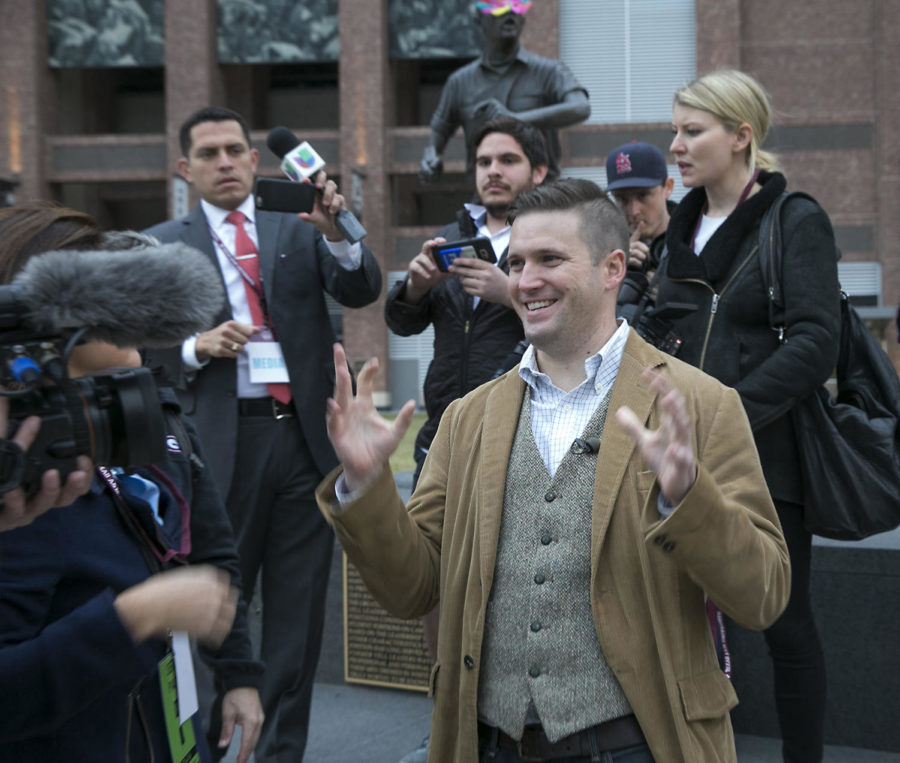Current hysteria has parallels with early 20th century
Richard Spencer, a white nationalist, takes a brief tour of Texas A&M campus on December 6, 2016, in College Station, Texas. On Saturday, Oct. 7, 2017, he led dozens of torch-wielding white supremacists in a rally at the Confederate statue in Charlottesville, Va., for the first time since a neo-Nazi attacked marching protesters, killing one. (Ralph Barrera/Austin American-Statesman/TNS)
October 25, 2017
The political and social upheavals that the country is going through now bear a striking resemblance to the events of the early 20th century. The housing boom before the Great Recession echoed the stock-market frenzy leading up to the Great Depression. Both eras experienced technological revolutions, waves of rapid globalization and a run-up in economic inequality. And both saw huge influxes of migrants to the U.S.
Given all of these parallels, it’s probably no surprise that U.S. society fractured along similar lines in both eras. In the 2010s, Americans are fighting over identity, race and belonging. Economic concerns, though still important, have temporarily taken a back seat to the fight over who gets to be a “real American.”
Meanwhile, a large number of surveys show that racial attitudes were one strong predictor of who supported Donald Trump in the 2016 election. This is no surprise — warnings about Islamic terrorism, labor competition from Mexico and Mexican organized crime figured prominently in Trump’s campaign. And since Trump took office, he’s been engaged in a number of high-profile confrontations with black critics. Meanwhile, recent surveys show that the two parties are increasingly divided by their views on race and immigration.
Advertisement
There are strong historical parallels to all of this: if anything, the backlash against immigrants and minorities is more restrained and less vitriolic this time around.
Beginning in the 1900s, new kinds of immigrants began arriving in the U.S. These were immigrants from southern and eastern Europe — particularly from Italy, Russia and the areas controlled by the old Austro-Hungarian Empire. The number of people added to the U.S. population was comparable, in relative terms, to the recent immigration boom:
That inflow of newcomers prompted a strong backlash from much of the existing American populace, which was primarily of northern European stock.
The hysteria over Italian immigrants 100 years ago eerily parallels much of the hostility Mexican immigrants have faced from the political right in recent decades. Italians were often vilified and stereotyped. Many Italians were lynched in American cities. After one particularly gruesome attack in 1891, a New York Times op-ed declared: These sneaking and cowardly Sicilians … are to us a pest without mitigation. Our own rattlesnakes are as good citizens as they … Lynch law was the only course open to the people of New Orleans to stay the issue of a new license to the Mafia to continue its bloody practices.
(Just for the sake of comparison, the Rochester Union Advertiser decried the lynchings as “deplorable.”) Italians, along with East European immigrants, were also sometimes perceived as potential terrorists. At the time, anarchism was on the march in Europe, and many Americans feared that immigrants would bring the most radical forms of that ideology into the country with them. Terrorist attacks roiled the country — President William McKinley was assassinated by a Polish immigrant anarchist, and there were a number of bombings that may also have been the work of anti-capitalist extremists.
The backlash against these new groups of Americans led to the harshest anti-immigration laws in the country’s history — the Emergency Quota Act of 1921 and the Immigration Act of 1924.
But the ethnic animus of the early 20th century wasn’t only directed at immigrants. A wave of anti-black racism swept the nation. The Ku Klux Klan experienced a dramatic revival in the booming 1920s — its membership soared into the millions, and 50,000 Klan supporters marched on Washington. Meanwhile, there was an unprecedented surge in the building of monuments to the Confederacy — many more such memorials were built in the first two decades of the 20th century than at any time before or since. Lynching of black Americans peaked slightly earlier, in the 1890s, but remained high until the 1920s.
Advertisement*
This anti-immigrant and anti-black sentiment arose during the Gilded Age — a time of great inequality, but also of rapid economic growth. When the Great Depression hit, a different kind of racist sentiment reared its head — fascism. A small but significant number of Americans, enamored of the Nazis and their theories of racial superiority, joined the trendy rightist movement. In 1939, 22,000 of them piled into Madison Square Garden to raise the swastika flag and give the notorious salute.
That ended with World War II. So did much of the rest of America’s anti-immigrant xenophobia — Italian and East European Americans fought in the war, intermarried at increasing rates and prejudice against them faded to a memory. Racial enmity toward black Americans, of course, continued.
It’s hard not to see the history of the 1910s repeating itself in the 2010s. Mexican immigrants have taken the place of Italians, and Islamism has replaced anarchism as the ideological bogeyman. And once again, racism targeting blacks has become more overt and aggressive, while neo-Nazis march in the streets.
So will modern history follow the same path? There’s a good chance that anti-immigrant hysteria will pass. Even without any changes to immigration laws, net Mexican immigration to the U.S. ended a long time ago; since 2005, more Mexicans have left the country (or died) than have entered it, and the Mexican-born population has fallen by about a million from its peak. With 39 percent of American-born Hispanics marrying non-Hispanics, it seems likely that Hispanic Americans will simply merge with the rest of the U.S. population within a couple of generations, and xenophobia will fade — just as it did for Italians.
Beyond that, it’s hard to predict. Fascist ideologies might have more appeal now that the U.S. is a declining global power instead of a rising one. And there will probably be no huge conflict like World War II in which all Americans are forced to fight on the same side.
So there’s no guarantee that anti-immigrant and racist attitudes will subside this time around. But there is certainly plenty of reason for optimism. The scale of alt-right marches doesn’t match the fervor of the KKK in the 1920s or the Nazi sympathizers in the 1930s, and the norms of the country have shifted against overt racism during the past century.
That gives us reason to expect that the current backlash will prove as temporary as the one 100 years ago.
___
(c)2017 Bloomberg News
Visit Bloomberg News at www.bloomberg.com
Distributed by Tribune Content Agency, LLC.
Advertisement








